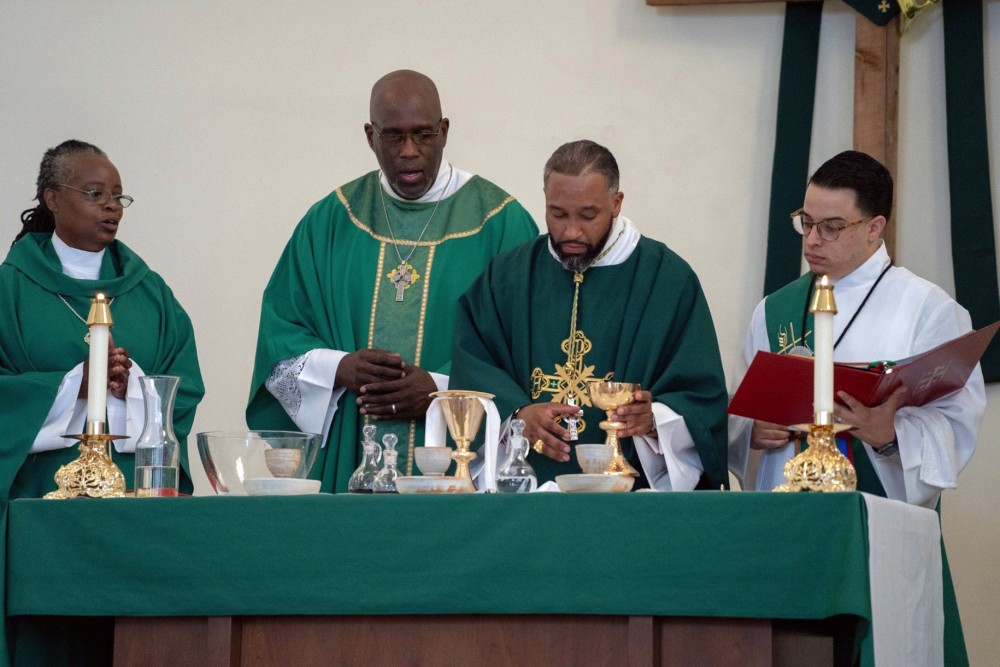Emerging movement suggests young Christians are hungry for liturgy, ritutal

Every service at the Cathedral at the Gathering Place begins with an incense-filled procession of the crucifer and the Gospel, followed by the singing of “Lift Every Voice and Sing,” also known as the black national anthem, before Emilio Alvarez, in full vestments, leads the congregation through the collect, scripture readings, and after the sermon, the Eucharist.
From the ritual smoke to the sharing of the bread, the experience would strike most cradle Pentecostals as utterly foreign. “For the first 15 minutes, you’d think you were in a Roman Catholic church,” said Alvarez. “But when I get up to preach, you’d swear we were Baptist.”
Read our latest issue or browse back issues.
Alvarez’s church in Rochester, New York, is one of roughly two dozen in the Union of Charismatic Orthodox Churches, a five-year-old group of mostly black Pentecostal churches in the Northeast and Australia dedicated to recovering the classical spirituality and theology of the early church mothers and fathers.
They are also part of a broader trend in which “low” or “free” church Christians, raised on contemporary worship services with praise bands and dim lights, are seeking out “high church” traditions replete with sacramental rituals and ancient liturgical language.
Chris Green grew up attending an independent Pentecostal church in rural Oklahoma. Today, Green, 43, is ordained in the Communion of Evangelical Episcopal Churches, a network of churches that celebrates the Eucharist far more regularly than the Pentecostal congregations of his youth. As a member of the Order of St. Anthony, a lay order in Tulsa, Oklahoma, he daily prays the morning and evening offices from the 1979 Book of Common Prayer.
Green is typical of the liturgical seekers Winfield Bevins wrote about in his 2019 book Ever Ancient, Ever New. Bevins, a North Carolina pastor affiliated with Asbury Theological Seminary, conducted an ethnographic study of 200 young adults who had recently begun worshiping in a formal liturgical style.
“It begins with a dissatisfaction with the state of the modern church, whether liberal or conservative,” Bevins told Religion News Service in a recent interview. “Some leave the church, and you get the rise of religious nones. However, there’s this growing number that have decided, rather than leave the church, they want to go back to the roots and by going back to the roots, they are experiencing spiritual renewal.”
Since the turn of the century, the movement has picked up momentum and has caught up young adults born as late as the 1990s.
In their book Back-Pocket God: Religion and Spirituality in the Lives of Emerging Adults, Melinda Denton and Richard Flory write that of 3,000 young conservative Protestants who participated in a National Study of Youth and Religion over a decade, 5 percent switched to a mainline denomination. These cradle evangelicals, they found, make up about one-third of mainline denominations, whose rites usually involve the reciting of creeds and set prayers.
Greg McCollum, a 24-year-old living in Ann Arbor, Michigan, has found himself more satisfied by the Episcopal Church’s relatively staid liturgy than the evangelical worship he grew up in. “I had friends who were very emotionally engaged in those worship services in a way that never really got me,” said McCollum. “In a way, I felt I was doing something wrong if I wasn’t being emotionally churned.”
However, some who have left the low church experience for more high church traditions are not as comfortable with mainline churches’ liberal socials views or feel the lack of emphasis on traditional Christian doctrines such as hell or the infallibility of scripture is a leap too far. Instead, they have made new spiritual homes in fledgling high church denominations that employ “smells and bells” ritual while embracing traditional doctrinal positions.
Chris Green’s CEEC, founded in the early 1990s, merges charismatic spirituality with evangelicalism’s anchor in scripture and Anglicanism’s sacramental vision.
For decades of the last century, many Americans, freed from the stained glass and archaic hymns of their childhood faiths, went in search of churches that felt more authentic and relevant to their suburban lifestyles. They landed in “seeker sensitive” churches with an indoor-concert vibe and plush campuses with coffee shops and gyms.
But seeker churches, said Tish Harrison Warren, can sometimes foster a shallow discipleship whose roots “aren’t deep enough to withstand the withering effects of modernity and skepticism, the suffering we all experience in life, and also our global and national conflicts around faith and race and meaning.”
Harrison Warren, who grew up Baptist, is now a priest at a Pittsburgh church affiliated with the Anglican Church of North America, a group of about 900 churches that split from the Episcopal Church over doctrinal matters. Traditional liturgy, she said, provides rootedness by connecting to the way Christians have worshiped for thousands of years. It is also, she observed, simply beautiful.
The focus on ancient rites above all seems to allow for a more ecumenical Christianity, one that emphasizes the importance of church creeds while sometimes holding other doctrines more loosely.
Katelyn Beaty, an author and editor who grew up evangelical and currently attends an Episcopal church, described an Episcopal church she attended in Chicago: “Our priest emphasized essentials and would say repeatedly that all our divisions fall away at the foot of the cross. There were strong theological and political differences represented in the congregation, but the people there had chosen to stay together as one body. . . . If the church falls neatly along the same political divisions, then is the church really that different from the world?” —Religion News Service






